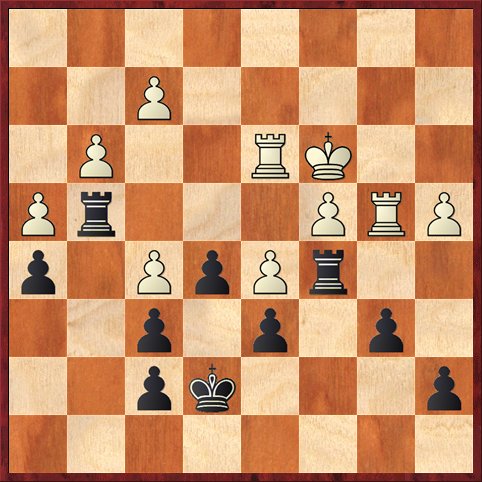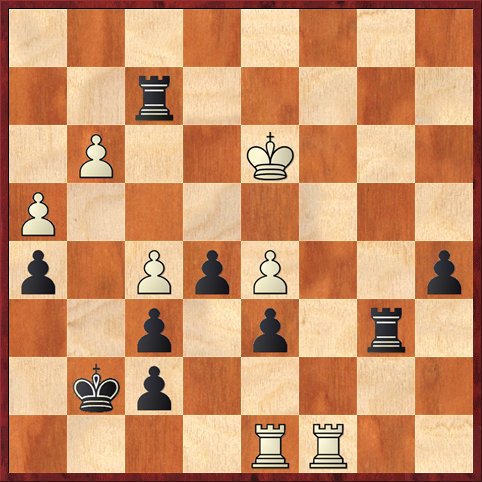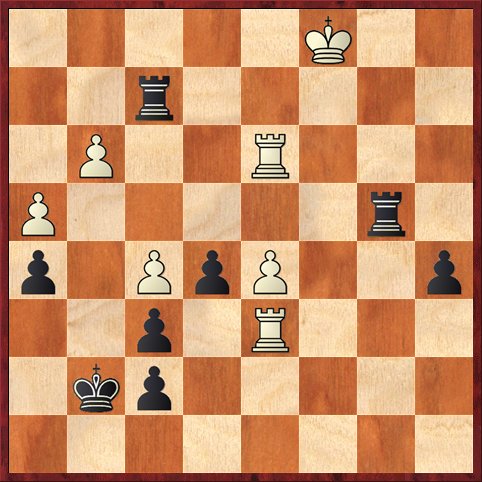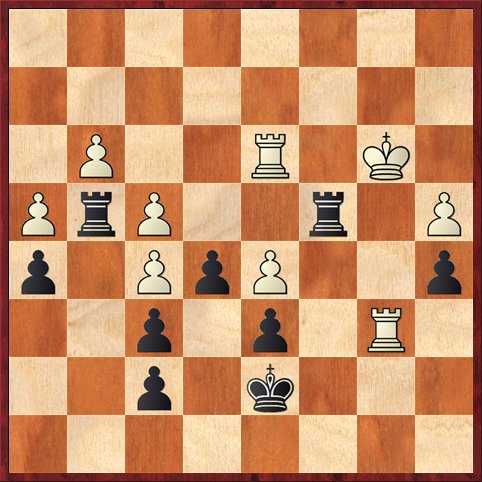Yesterday the 36th (almost) Annual Peoples Tournament concluded. It was pretty much of a lost weekend for me, or perhaps I should say a drawn weekend. After my excellent start, a win against Michael Aigner, I then spun my wheels with four straight draws before losing to Michael Aigner in the final round. Yes, that’s right — I played Michael twice in the same tournament. That is because he re-entered after his first loss to me. The tournament director, Richard Koepcke, was aware that he was pairing us for the second time, but with so few people playing (14 in the top section) it was unavoidable.
Actually, this is the second time in my life that I have played the same player twice in a tournament. It happened the first time in the 1995 World Open against an expert from Florida named Robert Whatley. That time our two games were only two rounds apart! He lost to me in the second or third round, re-entered, and then right after the merge, we were paired again, and I beat him again. It must have seemed to him like the movie “Final Destination,” where the characters try to cheat death and can’t do it. What are the odds, in a big tournament like the World Open with probably at least 100 players in the open section, that we would run into each other again?
Anyway, this “Final Destination” moment didn’t go so well for me. Michael, aka fpawn, got his revenge.
The game that will really stick with me as a lost opportunity, though, came in round five. I was matched against Evan Sandberg, one of the strong contingent of teenaged high experts to low masters. If you read my last post about Brian Wall, you know what was coming:
Evan Sandberg — Dana Mackenzie
1. d4 Nc6!!
I played this in honor of Brian; I have never played it before in my life, although I have played the Two Knights Tango (1. d4 Nf6 2. c4 Nc6) on a couple occasions. I’m giving it two exclamation points because that’s how many exclamation points Brian gives to most of his moves. 😎
2. e4 …
I was completely prepared to play the Full Metal Jacket (2. d5 Ne5 3. e4 e6 4. f4 ed!!) but my opponent didn’t go for it. Brian laments the fact that he can never get anyone to play 2. d5 against him. Interestingly, in the only game I ever played as White in this variation, against Bernie Schmidt in 1987, I did play 2. d5 Ne5 3. e4 e6, but then instead of 4. f4?! I played the more sensible 4. de fe 5. f4. Actually, I was rather pleased with myself because I knew that Bernie, an attacking player, would never want to trade queens, so I knew that he would play 4. … fe even though 4. … de was better.
Anyway, against Sandberg I played 2. … e5 and now we’re into a familiar e-pawn opening territory (which could have arisen by the move order 1. e4 Nc6 2. d4 e5). It’s not supposed to be particularly good for Black, but at least it’s not losing.
Now I’m going to fast-forward past lots of interesting stuff to get to the position where I missed my opportunity. After a somewhat dubious opening, my position got better and better until we got to this point, just after the time control:
Black to play and (probably) win.
In most chess games my biggest problem is taking too long when I don’t need to. In this game, I made the rare mistake of moving too quickly. I only took 4 minutes on this move, and did not penetrate deeply enough into the position.
I think that my first inclination was to play 31. … a5, but it looked risky, because after 32. Rxb6 Rcxc4+ 33. Kb3 Rxa4 he can get counterplay with 34. Rb7+ Kf8 35. Rb8+ Kg7 36. Rd8, and I thought my d-pawn was falling. But there is much more to this position! I can continue 36. … Rgb4+ 37. Kc2!
White sets a devilish trap. Do you see what is wrong with 37. … Rb6?
Here it looks as if Black can just play 37. … Rb6? and remain a pawn up. However, White has a wonderful resource:
(space inserted for those who want to think about it)
38. Rc3! …
With the idea of 39. R3c8 and checkmate to follow! Now Black does not have time for 38. … Ra2+ 39. Kd3 Rxf2 40. R3c8 because after 40. … Rxf5 it’s still mate with the White rooks on g8 and h8! This is almost like the end of a helpmate problem. It’s worth another diagram:
Black is powerless to avoid checkmate.
One reason for giving this long-winded variation is that it beautifully illustrates Rule Number One of Double-Rook Endgames: Always remember that two rooks are mating material! This rule will save you a lot of games.
Instead, from Diagram 2 above, Black should have put his pedal to the metal and gone after the f2 and f5 pawns right away. Thus, 37. … Ra2+ (instead of the lame 37. … Rb6?) 38. Kc1 (White is forced back here because he cannot allow 38. Kc3 Ra3+ 39. Kd2 Rxd3+ 40. Kxd3 Rd4+ 41. K c3 Rxd5, and Black has two extra pawns and ought to win easily) 38. … Rxf2. Now the Rc3 trick doesn’t work for White, because Black has enough time to take on f5 and then move his rook away from f5 (and he can even do it with check, gaining a tempo). So White has to settle for 39. Rxd6. It’s still a complicated, but I think Black is winning here. I will leave it as an exercise. Don’t forget Rule One of Double Rook Endgames, which Black can use to his advantage in some lines because White’s king is pinned to the back rank.
Analysis project: Is Black winning?
Okay, now let’s go all the way back to the first position and see what I did wrong. Instead of the risky 31. … a5!, I thought that Black had a risk-free winning procedure with 31. … Kd7?, and so that is the move I played. The idea is to protect the b-pawn and then play … a5. This works like a charm if White plays 32. Rd2 Kc7 33. R2b2, which I was expecting, because I would follow up with 33. … Rd4! and White is in zugzwang. But again, I was too hasty and failed to see the plan that Sandberg found, 32. Kb3! with the simple idea of 33. Rc3. White defends all of his weak points and Black cannot break through. So now I realized that, in order to play for a win, I had to try 32. … a5, the move I should have played a move earlier. He played 33. Rxb6 with pleasure, and I played 33. … Rcxc4.
Notice that my ill-chosen move 31. … Kd7 has cost me a key tempo, by comparison with the line above. It meant that I did not capture on c4 with check. Also, my king is farther from the kingside pawns, so that White now has possibilities of playing Rb7+, Rb8+ and Rh8, although that is not what he chose to do.
Sandberg came up with a nice way to take advantage of these slight changes to the position:
34. f4! …
Position after 34. f4!
Cutting the communication between Black’s rooks. Notice that this would also have been possible in the lines I analyzed earlier, but in those lines Black would have already captured on a4. Once again, the tempo makes a big difference! Now Black’s best is probably 34. … Rc7, but I was so flummoxed that I made things even worse with34. … Rb4+? 35. Rxb4 ab 36. Rf3! ef 37. Rxf4 Rxg3+ 38. Kxb4 Rd3 39. Kc4 Ra3 40. Kb4? Rd3 ½-½
Draw?
An amazing stroke of luck for me! After handling the defense perfectly, my young opponent for some reason thought he had nothing better than a repetition of position here. I think he would have been completely winning after something like 40. Kb5 Rd3 (40. … Rb3+? 41. Rb4 is no better) 41. a5 Rxd5+ 42. Kb6 Rd1 43. Rb4!
So … A missed opportunity for me, and also for my opponent. This game is a good illustration of Rule Number Two for All Rook Endgames (not just double-rook endgames), which is: No guts, no glory. In most other endgame, playing it safe and limiting your opponent’s counterplay is usually a good strategy. But in rook endgames, most of the time you have to play risky chess to win. That’s what makes them so hard. In the first position I made the mistake of trying to play a risk-free line, and so I missed the win. In the final position, my opponent was too risk-averse to sac the d-pawn, and so he missed a win too.
This has been a longer entry than I expected, but I should finish my job as a reporter and say that Ricardo de Guzman won the tournament (no surprise there) with 4.5 out of 6, and Yian Liou tied with Michael Aigner for second with 4. In the 1900-2100 section, a player named Nicholas Karas had a very impressive result of 6 out of 6. I asked him for a copy of one of his games, and I might go over it in a future blog post or lecture.
Cailen and Thadeus, who went to the tournament with me, both had disappointing weekends. Cailen went 3-3, and Thadeus, after having his 12-game winning streak broken in round 2, had a result of 2.5-3.5. I think this was one of the first poor tournaments he has ever had, so it came as a little bit of a shock to him. However, he did win very nicely in the final round.









{ 1 comment… read it below or add one }
Try that 499 more times and you will surely reach a Full Metal Jacket